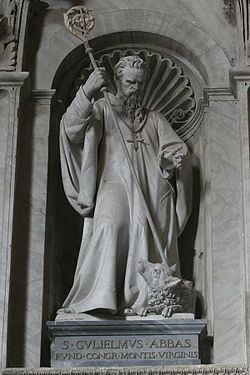Name William Montevergine | Attributes wolf; crosier Feast June 25 | |
 | ||
Died June 25, 1142, Sant'Angelo dei Lombardi, Italy | ||
Venerated in Roman Catholic Church | ||
William of montevergine
William of Montevergine, or William of Vercelli, (Italian Guglielmo) (Latin Gulielmus) (1085 – 25 June 1142) was a Catholic hermit and the founder of the Congregation of Monte Vergine, or "Williamites". He is venerated as a saint by the Roman Catholic Church.
Contents
- William of montevergine
- Saint william of montevergine june 25
- Life
- The Miracle of the Wolf
- At king Roger IIs court
- References

Saint william of montevergine june 25
Life
He was born in 1085 into a noble family of Vercelli in northwest Italy and brought up by a relation after the death of his parents. He undertook a pilgrimage to Santiago de Compostela. On his pilgrimage to Compostela, William asked a blacksmith to make an iron implement that would encircle his body and increase his suffering, and he wore it throughout the pilgrimage.
After he returned to Italy, he intended to go to Jerusalem and for this purpose he reached South Italy, but he was beaten up and robbed by thieves. William considered this misfortune a sign of God's will to stay in South Italy and spread the message of Christ. Because of this, he decided not to travel to Jerusalem anymore and to settle in South Italy, on the summit of Monte Vergine (then known as Monte Vergiliana) between Nola and Benevento, where he lived as a hermit. Here he attracted a number of followers and founded the Monastery of Montevergine.
While at Montevergine, William of Vercelli is stated as having performed miracles. Roger II of Sicily served as a patron to William, who founded many monasteries for men and women in Sicily. The Catholic Encyclopedia states that Roger built a monastery opposite his palace at Salerno in order to have William always near him.
The inflow of the faithful was for the priests the opportunity to exercise their ministry, and the hermit life that William sought was compromised. Moreover, his confreres did not tolerate that lifestyle too austere and full of privations. Therefore, he left Montevergine in 1128 and settled on the plains in Goleto, in the territory of Sant'Angelo dei Lombardi, between Campania and Basilicata, where he began a new monastic experience, a double monastery built mostly by women.
Subsequently, he founded several other monasteries of the same rule, but mostly remained in Goleto except for some trips to Apulia. Eventually he died in Goleto on June 25 1142. His remains were buried in Goleto, where they stayed until they were transferred to Montevergine on September 2, 1807, as ordered by the king of Naples Gioacchino Murat. Some of his relics are also located in other cathedrals (Benevento) and Italian churches. Catholic tradition states that William foresaw his own imminent death “by special revelation”.
The Miracle of the Wolf
According to all the sources, including the earliest source - "Legenda de vita et obitu sancti Guilielmi Confessoris et heremitae", all of which close to Catholicism, he performed many miracles. The best known miracle was (1591), and still is, the "Miracle of the Wolf". Because of this, he is often depicted in company with a "domesticated" wolf, even in the monastery of Montevergine. One day a wolf hunted and killed a donkey the saint used for towing and other tasks. The saint then turned to the wolf and ordered the beast to offer himself to all the previous donkey's tasks. The wild beast reportedly became tame and the people who met the saint were astonished to see such a docile wolf.
At king Roger II's court
Hagiographer Tommaso Costo (1591) wrote that king Roger II of Sicily had heard about William of Montevergine, and thus he wanted to meet him. The king reportedly was living in Salerno at that time. Reportedly, while visiting the king, a prostitute wanted to prove the genuineness of his faith, and, complicit with the king, tried to get into William of Montevergine's bed who, in response, put burning embers on his bed and there he lay down, inviting the prostitute to follow his example. Reportedly the woman repented of his mistake and switched to a more religious life.
Posthumous sources add further details, stating that the prostitute had been called Agnes and that, after conversion, she had built a monastery in Venosa, where she led a monastic life with other women, being called "Blessed Agnes of Venosa". Hagiographer Tommaso Costo, already in the 16th century, dismissed the second part of the story, there being no mention of it in the main and most reliable source, the Legenda de vita et obitu sancti Guilielmi Confessoris et heremitae.
